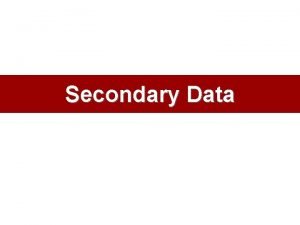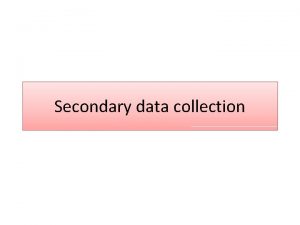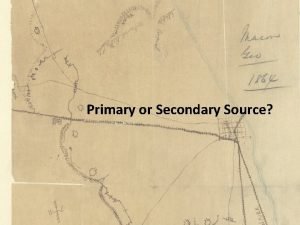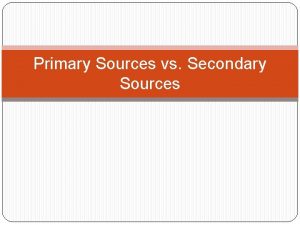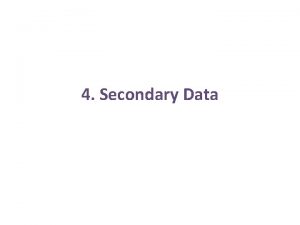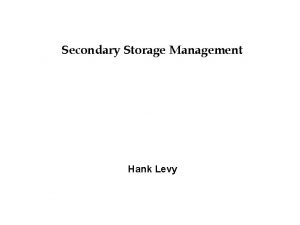CHAPTER 5 SYNDICATED SERVICES Syndicated Sources of Secondary





















- Slides: 21

CHAPTER 5 SYNDICATED SERVICES

Syndicated Sources of Secondary Data Syndicated services, or syndicated sources, are companies that collect and sell common pools of data of known commercial value , designed to serve information needs shared by a number of clients. These data are not collected for the purpose of marketing research problems specific to individual clients, but the data and reports supplied to client companies can be personalized to fit particular needs. Syndicated services can be classified on the unit of measurement (household/consumers or institutions).


Syndicated data from households Surveys: involve interviews with a large number of respondents using predesigned questionnaire. Often these surveys are conducted on samples drawn from panels. Panels are samples of respondents who provide specified information at a regular intervals over an extended period of time. These may be organizations, households, or individuals, although household panels are most common. Comprehensive demographic, lifestyle, and product-ownership data are collected only once each respondent is admitted into the panel.

Syndicated data from households Syndicated panel surveys measure the same group of respondents over time but not necessarily on the same variables. A large pool of respondents is recruited to participate on the panel. From this pool, different subsamples of respondents may be drawn for different surveys. Any of the survey methods may be used, including telephone, personal, mail, or electronic interviewing. The content and topics of the surveys vary and cover a wide range.

Syndicated data from households Psychographic and lifestyles: Psychographics refer to the psychological profiles of individuals and to psychologically based measures of lifestyles. Lifestyles refer to the distinctive modes of living of a society or some of its segments. Together, these measures are generally referred to as Activities, Interests, and Opinions, or simply AIOs. Advertising evaluation: The purpose of advertising evaluation surveys is to assess the effectiveness of advertising using print and broadcast media. General surveys: Surveys are also conducted for a variety of other purposes, including examination of purchase and consumption behavior.

Syndicated data from households Advertising evaluation: The purpose of advertising evaluation surveys is to assess the effectiveness of advertising using print and broadcast media. Evaluation of effectiveness is even more critical in the case of TV advertising. TV commercials are evaluated using either the recruited audience method or the in-home viewing method. In the recruited audience method , respondents are recruited and brought to a central viewing facility such as a theatre or mobile viewing facility. The respondents view the commercials and provide data regarding knowledge, attitudes, and preferences related to the product being advertised and the commercial itself. In the home viewing method, consumers evaluate commercials at home in their normal viewing environment.

Syndicated data from households General surveys: Surveys are also conducted for a variety of other purposes, including examination of purchase and consumption behavior. Uses of surveys: 1)They can be used for market segmentation, as with psychographics and lifestyles data, and for establishing consumer profiles. 2) They are also useful for determining product image, measurement and positioning and conducting price perception analysis 3)They can be conducted for advertising theme selection and evaluation of advertising effectiveness.

Advantages and Disadvantages of Surveys Advantages • Most flexible • Focus on only a certain segment of the population • Only way of obtaining information about consumers’ motives, attitudes, and preferences • A variety of questions can be asked, and visual ads, packages, products, or other props can used during the interview. Disadvantages • Rely on self-reports • There is a gap between what people say and what they actually do • Errors might occur • Samples may be biased, questions poorly designed, interviewers not properly instructed, and results misinterpreted.

Purchase and Media Panels Often, survey data can be complemented with data obtained from purchase and media panels. The distinguishing feature of purchase and media panels is that the respondents record specific behaviors as they occur Previously, behavior was recorded in a diary, and the diary was returned to the research organization every one to four weeks. Paper diaries have been gradually replaced by electronic diaries. Now most of the panels are online and the behavior is recorded electronically, either entered online by the respondents or automatically by electronic devices.

Purchase and Media Panels Purchase panels: In purchase panels, respondents record their purchases of a variety of different product. Media panels: In media panels, electronic devices automatically record viewing behavior, thus supplementing a diary or an online panel. Uses of purchase and media panels: 1) Purchase panels provide information useful forecasting sales, estimating market shares, assessing brand loyalty, and brand switching behavior. 2) Purchase panels are useful for establishing profiles of user groups, measuring promotional effectiveness, and conducting controlled store tests. 3) Media panels yield information helpful for establishing rates by radio and TV networks, selecting appropriate programming, and profiling viewer or listener subgroups.

Advantages and Disadvantages of Purchase and Media Panels Advantages • Provide longitudinal data • People in panels may provide more and higher-quality data than surveys • In purchase panels, information recorded at the time of purchase, eliminating recalls error • Information recorded by electronic devices is accurate because it eliminates human error. Disadvantages • Lack of representativeness, maturation, and response biases

Electronic Scanner Services Scanner data are collected by passing merchandise over a laser scanner, which optically reads the bar-coded description (UPC- the Universal Product Code) printed on the merchandise. Three types of scanner data available. Volume tracking data: provide information on purchases from brand, size, price, and flavor or formulation, based on sales data collected from the checkout scanner tapes. This information is collected nationally from a sample of supermarkets with electronic scanners. Scanner panels: each household member holds a ID card. They simply present their ID card at the checkout counter each time she/he shops. In this way, consumer identity is linked to products purchased as well as the time and day of the shopping trip. The firm can build a shopping record for each member.

Electronic Scanner Services Scanner panels with a cable TV: combines scanner panels with new technologies growing out of the cable TV industry. Households on these panels subscribe to one of the cable TV systems in their market. By means of a cable TV “split”, the researcher targets different commercials into the homes of the panel members. Uses of scanner data: 1) National volume tracking data can be used for tracking sales, prices, distribution, modelling, and analyzing early warning signals. 2) Scanner panels with cable TV can be used for testing new products, repositioning products, analyzing promotional mix, and making advertising decisions, including budget, copy and media.

Advantages and Disadvantages of Electronic Scanner Services Advantages • Reflect purchasing behavior that is not subject to interviewing, recording, memory, or expert biases • The record of purchases obtained by scanners is complete and unbiased by price sensitivity • In-store variables like pricing, promotions, and displays are part of the data set • The data are also current and can be obtained quickly • Scanner panel with cable TV provide a highly controllable testing environment Disadvantages • All products may not be scanned. Thus, transaction is inaccurately recorded. • In scanner TV panels, the system provides information on TV sets in use rather than actual viewing behavior. • They do not provide information on underlying motives, preferences and reasons for specific purchasing choices.

Syndicated data from Institutions Retailer and Wholesaler Audits: a formal examination and verification of product movement traditionally carried out by auditors who make in-person visits to retail and wholesalers and examine physical records or analyze inventory. Audit data focus on the products or services sold through outlets or the characteristics of the outlets themselves. With the advent of scanner data, the need to perform audits has greatly decreased. Uses of Audit data: 1) Determining the size of the total market and the distribution of sales by type of outlet, region, or city. 2) Assessing brand shares and competitive activity 3) Identifying self space allocation and inventory problems 4) Analyzing distribution problems 5) Developing sales potentials and forecasts 6) Developing and monitoring promotional allocations based on sales volume

Advantages and Disadvantages of Audit Data Advantages • Provide relatively accurate information on the movement of many different products • This information can be broken down by a number of important variables, such brand, outlet type, and size of the market Disadvantages • Limited coverage • May not be timely or current • Cannot be linked to consumer characteristics.

Industry services provide syndicated data about industrial firms, businesses, and other institutions. These data are collected by making direct inquires; from clipping services that monitor newspapers, the trade press, or broadcasts; and from corporate reports. The range and sources of syndicated data available for industrial goods firms are more limited than those available for consumer goods firms. Uses of industry services: 1) Information provided by industrial services is useful for sales management decisions including identifying prospects, defining territories, setting quotas, and measuring market [potential by geographic areas. 2) It is also useful for advertising decisions such as targeting prospects, allocating advertising budgets, selecting media, and measuring advertising effectiveness. 3) It also aids in segmenting the market and designing content, quantity, and quality of information.

Advantages and Disadvantages of Industry Services Industry services represent an important source of secondary information on industrial firms. The information they provide can be valuable in the initial phases of a marketing project. However, they are limited in the nature, content, quantity, and quality of information.


Figure 4. 7 Sources of Secondary Data for International Marketing Research International Secondary Data Domestic Organizations in the United States International Organizations in the United States Organizations in Foreign Countries Government Sources Trade Associations Nongovernment Sources International Organizations
 Is syndicated data secondary data
Is syndicated data secondary data Syndicated sources of secondary data
Syndicated sources of secondary data What are the secondary data
What are the secondary data The terms external secondary data and syndicated
The terms external secondary data and syndicated Print sources of information
Print sources of information Importance of water resources
Importance of water resources What is a primary source
What is a primary source Primary secondary and tertiary sources
Primary secondary and tertiary sources Is an illustration a primary or secondary source
Is an illustration a primary or secondary source What is a secondary source
What is a secondary source Secondary light sources
Secondary light sources Leveraging secondary brand associations
Leveraging secondary brand associations Ornaments primary or secondary source
Ornaments primary or secondary source Whats a primary source
Whats a primary source Secondary sources
Secondary sources Why is autobiography a primary source
Why is autobiography a primary source Secondary sources
Secondary sources Secondary sources
Secondary sources Secondary sources
Secondary sources Secondary sources of history
Secondary sources of history Primary sources autobiography
Primary sources autobiography Venn diagram of primary and secondary succession
Venn diagram of primary and secondary succession

